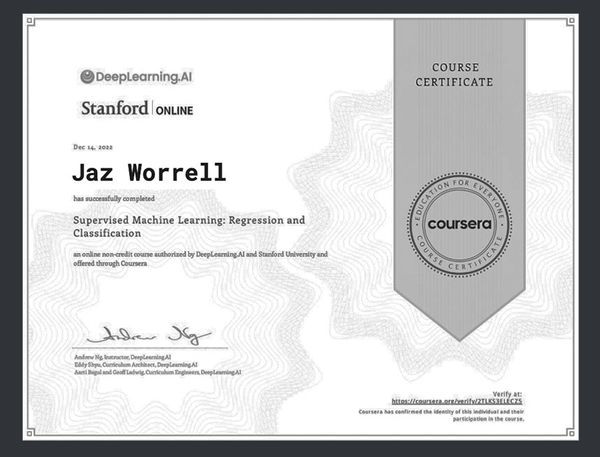Introduction
The metaverse is coming. In fact it’s already here. Multiple virtual ‘universes’ already exist where real people are living an alternate reality. The Sandboxdescribes itself as a place to ‘Play, Create, Own, and Earn in a virtual world made by players’. It’s a very attractive reality where you can be whoever you want to be. You can also make money there. Even better!

‘The metaverse will host most of your office meetings within ‘two or three years’ – Bill gates
When Bill Gates said ‘the metaverse will host most of your office meetings within ‘two or three years’ – it’s no joke. The human: human interactions in a virtual world will no doubt be an evolutionary cornerstone of the technology. However, what interests me is the intersect between life and computer. Human and robot.
Artificial intelligence in the metaverse will have a profound impact on our experience. How will the advances in this technology affect those experiences? How will this also evolve?
This article attempts to address some of those questions and looks at some potential executions. I will definitely dig into greater depth on some of these topics as it’s easy to get lost down the rabbit hole here. The potentials are staggering, the implications huge.
Anyway, enough drama. Let’s get started:
Non-playable characters (NPC’s)
Since the very first games, NPC’s have populated our virtual worlds. It’s always been easy to tell these characters apart. They would stand or idle in restricted zones, have predictable conversations, offer predictable quests and always have a hovering icon above their heads to indicate interaction. Any … was more of an interaction than a conversation.
As technology evolves, so too have these wholesome characters. Interactions, graphics, animation all scaled to offer deeper complexity and realism. Essentially, AI chatbots have been integrated into walking, talking 3D avatars that give the illusion of self thought and contemplation.
An exciting development for the future is how predictive modelling could influence storyline and plot – where NPC’s now make strategic decisions based on player activity to trick or confuse. Imagine a war strategy game where your opponent could observe and adapt based on your gameplay. This already exists with real-time strategy (RTS) games such as Age of Empires, but this level of learning and prediction could advance the genre to a whole new level.
Alpha Go was a computer program based on deep neural networks that did just this for the game Go. It used ‘reinforcement learning’ in games against itself to increase skill and win:rate – ultimately defeating a professional human in arguably the most complex game for AI.
Obviously there is a different conversation around ‘how difficult’ should a game be?…but titles such as Diablo have a great system where you can increase difficulty almost indefinitely. Torment levels are essentially the same game but with increased loot, enemy health, damage and varying skills.
Deepfake Media
You can take all this to the next level with deepfake technology. Neon, a subsidiary of Samsung, recently released this ‘vision of the future’ where these next-level ‘artificial humans’ were presented as stylists, presenters and trainers.
This technology is slightly different, as they were modelled on real humans however imagine this on a larger and more refined scale. The Amazon original series Upload also features a reality just like this! The power of an advanced deep learning AI in a human avatar – incredible.
What starts to get very interesting are the potential applications of this tech outside of just gaming. Education has always been of great interest to me, so we’ll start there.
Education and the metaverse
During secondary school I started to question the learning process and the curriculum presented to kids aged 4-18. I was very fortunate to attend good schools but the experience was unequivocally boring. I have incredibly strong and fond memories of my primary school where I started at the age of 3. All classes were small, intentensly interactive, challenging and fostered an environment of failure. To quote a modern phrase, we would fail fast, learn fast. This certainly dropped off as I went through the school system.
Of course, some of this was due to age, but also curriculum and teaching style. Was any of this relevant, and why do I have to decide a career projection so early?
As I’ve grown and chosen to seek knowledge on a whole range of topics, it’s obvious that the world is not boring. Science and math is not boring but I certainly found it that way. What excites me about AI and the metaverse is it’s potential to revolutionise education for everyone. By utilising some of the technology we’ve already spoken about, the traditional classroom can be transformed into a virtual world of interactive and applied learning.
All of a sudden, maths isn’t just a textbook with a bunch of arguable pointless exercises. Now, it’s a money management simulation where you and your class have to control the finances for a theme park or create a budget to survive 12 months in a new city. This is real-world learning and something I felt was missing from the school experience. I will write a whole post on the education system as it is very close to my heart in terms of ideas I have for improvements, but for now let’s stick to how the metaverse can help… This video from Meta (how could I not include them in this blog) is a great conversation starter for this industry:
Side Note:
I currently work for a medical company with a brand that supplies simulation equipment for medical training. Picture yourself as an aspiring surgeon. Without a real body to practice on, your options are VERY limited. These metaverse environments can be used to not only test skills but also simulate highly stressful scenarios. Scenarios such as surgery and war that traditionally get ‘tested’ on the ‘front line’. A place with zero second chances.
Customised learning paths & assessment
Part of the difficulty teaching in a school environment is balancing time and resources to individual students. Many of my friends had additional tutors to fill the gap between what we were being taught and what we understood. After a set period of time, the class must progress to the next topic as we need to cover everything in the syllabus. Some students would get left behind, others would get bored.
What fascinates me about the potential of AI in the metaverse is customised learning paths for each student. We all progress in different subjects at a different pace. Some of us need to spend more time on one concept and less on another. AI can be used to assess, monitor and tweak learning paths for all students. Those that show a proficiency can move onto more advanced concepts and the help is there for the others that need it. At no point do you feel ostracised or overly-challenged as the system can identify and manage your interactions. A traditional hour lesson in the classroom, may now be 20 minutes of intense virtual activity in the metaverse. Study doesn’t have to be boring and with this there are SO many options to make it exciting.
Duolingo research is an entire science department delving into language, education and the crossroad with technology. One of their papers investigates a method for ‘rapidly creating language proficiency assessments‘ and then using this to tailor personalised learning plans. When you start to combine research like this and present applications in an environment driven my creativity and immersion – the possibilities are endless. I sound like a wacko-tech-visionary now, but stay with me.
The research is there, the tech is there. Imagine ‘travelling’ to Spain in the metaverse for your spanish class. No more reitering verb tables in a classroom, but instead face to face conversation practice in a Barcelona cafe. No more rehearsed stories about shopping with your parents on the weekend, but actionable phrases you can use and apply on holiday.
Instant feedback
Language learning apps are a great segway into the metaverse as there is a lot of transferable tech into this space. Coding tools I’ve been using over the past 6-12 months also have similar interfaces; Codecademy and Datacamp for instance.
The power of instant feedback in a educational setting is invaluable as the student can learn about mistakes, improvements and a simple ‘ correct or incorrect’ assessment immediately after completing an exam. No waiting, no stressing.
Teacher bias is removed from any marking and it frees up their time for more quality teaching. On average, teachers are spending up to 90 minutes extra a day grading tests. This is not a good use of their time.
Disclaimer. I’d like to mention here that teachers do they best they can do. the majority are in it for the right reasons and many throughout my life have made a lasting, positive impression and impact. It’s now our responsibility through technology to make their lives easier and give students (of all ages) a better tailored, personalised and iterative learning experience. Teachers will never be replaced by AI, but there is a strong overlap with how it can support.
Private Tutors
Although I JUST said teachers will never be replaced, the metaverse opens up THE WORLD to the fingertips of anyone with access. Any student could attend a lecture by a world-leading scientist if it was hosted in the metaverse.
For two years I had spanish lessons with a tutor from Argentina. For me, it was a requirement to learn from a native. We met in person a couple of times and our learning material was always basic but sufficient – textbooks, videos, short stories. Imagine the possibilities when the environment is your ‘textbook’ instead. Immersion has a part to play in any learning journey and the metaverse enamates this.
Could you also hire an AI tutor with the appearance of a NEON avatar? Would this be cheaper? They’d always be available, willing, upbeat and entirely focused on you. You could study in your own time and the syllabus would constantly adapt to your level. There’s a lot of benefits when done right.
I mentioned virtual lectures just now so let’s move onto entertainment and how some of this could realistically be executed. Plot twist – it’s already happening!
Entertainment
I recently stumbled across a site called Virtual Humans that totally blew my mind. As of today, Instagram has verified 35 virtual influencers on the platform. Let me make that clear, these aren’t real people. They are computer generated avatars composited into the real world. The have real photos, a real following and can generate some serious money. PUMA recently chose virtual influencers to advertise their new shoe and other brands are lining up for the opportunities. (Side note: building one of these personas could be a cool side-project!)
An anime music sensation know as Hatsune Miku, has sold out concerts both online and offline since her first appearance in 2007. Real-life artists are now taking to the metaverse to perform exclusive shows, concerts and custom entertainment. Artists such as Travis Scott, The Weeknd (a live tiktok experience) and Ariana Grande premiered her virtual concert on Fortnite with over 78 million players in attendance! According to the news site theface.com:
According to Forbes, it is anticipated that Grande will likely receive tens of millions of dollars and merchandise sales from her Rift Tour stint, while The Independent reported the concert to be a stepping stone in Fortnite’s endeavour to create a “metaverse”
It’s not just innovative artists taking the leap. Now entire studios such as Warner Music Group are in discussion to make an ongoing concert series.
There is a LOT to break down here, but you can already see the huge possibilities in this entertainment space. It may sound crazy to some, but as more of us become comfortable in digital spaces, this type of output is inevitable. Entertainment on demand has a whole new meaning.
Business & Finance
I started this article with the quote from Bill Gates around meetings in the metaverse. With the HUGE shift online since COVID, many people have had to accustom themselves to online work and it’s been exhausting. Although at times it’s been stressful, the transition has actually been very smooth. For the companies that can manage with Zoom it’s been a great solution and one that will no doubt stand the test of time.
We’ve already seen new jobs arise and responsibilities change with this transition. Office managers and HR for one have had to adapt to the changing needs and stresses of a virtual environment. In a previous job, I saw these roles were suddenly responsible for arranging virtual team events and ‘checking in’ on mental health.
Funnily enough, a lot of middle management have also been struggling to justify their positions. With some of us working a lot more productively from home, it’s harder to prove value when you can’t been seen moving around and interacting at the office.
As part of the 2021 Sandbox teaser, they allude to 4 new digital jobs created from the metaverse; Architect, Land Owner, Hoster and Performer. A digital host is now a real thing. A real job. Just think about that!

The Sandbox New Official Teaser 2021 – Gaming Virtual World with NFTs on the Blockchain
Moreover, the potential and possibility to move full-time into a more interactive space is easily done. Widespread adoption of the technology will be required, but if Microsoft was to release something with their teams app (for example), the barrier to entry would be silky smooth. When you start to combine this new environment with AI apps currently in circulation, you once again have the potential to revolutionise the industry.
AI note-taking apps could analysis, record and identify tasks from meetings. These tools already exist in a rudimentary form, but combine these with human/ robot avatars and they’ll become almost like a member of the team. Virtual worlds that serve as the storefront to your business could have a 24/7 concierge or receptionist. Always available to answer any questions and no need to queue.
You can see this already starting to take shape in The Sandbox. Companies are buying up huge areas of digital real-estate to open concept stores, host virtual events and sell physical product. Imagine these new ‘high streets’ as the tutorial area for new players. It’s like having a store on Oxford Street or the centre of New York. Players can explore, interact AND spend!

Virtual Real Estate SOLD in The Sandbox
Recruitment systems could be augmented to provide virtual interview environments. These spaces and interactions would allow instant feedback and the chance for more complex testing. Imagine hiring for new 3D artists. You could invite 10 applicants to the same space (or virtual office), ask them to model something live in front of a panel and see how it fits into the company brand. The Sandbox already has over 3400 assets on it’s marketplace – give it a year and see how this number will explode!
Language and Communication
The final thing I wanted to touch on is how communication and language will evolve in the metaverse. AI has already begun to transform how humans communicate with each other. Headphones now exist that can translate languages in real-time, essentially removing the friction between current communication. This was best described in an article I found on Medium entitled, The Language of the Metaverse:
In the metaverse, I suspect we will have a native “Google Translate” that will convert our speech into the speech of the person’s native tongue of whom we are conversing with. And vice versa.
In the metaverse you could seamlessly live your life. Chat, collaborate and build with other players from all over the world and only speak one language. Perhaps this is your primary tongue or another more native to the virtual world. This sort of technology has been seen in sci-fi films for years but is now very much a reality.
It opens the door to international business, new friendships and maybe love. 😉
Summary
To finish as I begun, the metaverse is coming. With it comes a whole range of new technologies, experiences, jobs, entertainment and relationships. The intersect with this and artificial intelligence will continue to transform the way we communicate and live day to day. How both evolve in tandem will be interesting to observe. The rise of virtual influencers will play a key role in accelerating this end-state vision. With key real-life figures spearheading the adoption of the wider technology.
Somethings may sound far-fetched but an entire generation of humans have been born and raised online. We already play games, we chat and we play in virtual apps and worlds. Taking it to the next level is only a step away.
There is so much here that i’d like to investigate deeper. As I improve my own knowledge of coding and machine learning, perhaps there are also some projects and assets I can contribute to the field. Either way, there is a lot to unpack.
Thanks for reading.








